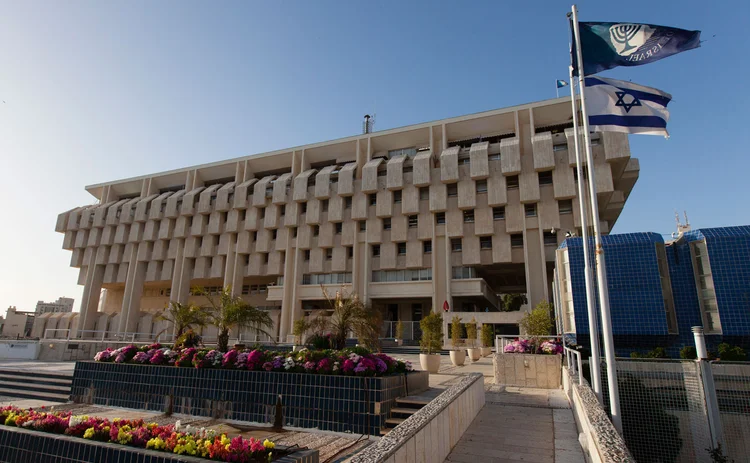
Reserve manager of the year: Bank of Israel
For its portfolio optimisation and breakthroughs in sensitivity analysis

The Bank of Israel's reserves more than tripled in value since 2008, to stand at $98 billion at the end of 2016. This was part of a conscious effort by officials to increase foreign exchange holdings, which were determined to be far too low, one of the lessons of the Asian financial crisis of 1997.
Building up foreign exchange, however, was not a quick process. Persistent weakness of the shekel in the years surrounding the millennium meant any significant increase in reserves was not feasible – their accumulation would have placed further pressure on the currency, and undermined monetary and broader economic policy objectives. But things changed after the global financial crisis, as large portfolio flows poured into emerging markets such as Israel, where it pushed up the value of the shekel against hard currencies.
Andrew Abir, head of the Bank of Israel's 65-strong market operations department, says the central bank viewed the rise of the shekel as exaggerated, considering economic fundamentals. As a result, it made sense to increase reserve levels, since buying foreign assets would help to limit the rise of the currency and "fitted in" with achieving the goals of monetary policy.
"It was only after the global financial crisis that the large volumes of portfolio inflows allowed the central bank to build up forex [foreign exchange] reserves without having an undesired detrimental impact on the currency," Abir says.
Reserves were allowed to grow to a level where they represent around one-third of annual GDP. They should now help Israel to meet "eclectic" needs, including dealing with the impact of a financial crisis and ensuring the country would be able to meet its financing requirements, even in the event of a major earthquake or a large-scale military conflict.
It was only after the global financial crisis that the large volumes of portfolio inflows allowed the central bank to build up forex reserves without having a detrimental impact on the currency
Andrew Abir, Bank of Israel
"When we look at the various levels of measurements for reserves coverage, Israel is somewhat high, but this can be justified due to its geopolitical position," says Abir.
Following the discovery of several major natural gas fields over the past few years, the Bank of Israel created a framework of intervention to "moderate the effect of natural gas production on the exchange rate", according to the market operations department's Investment of the Foreign Exchange Reserves 2015 annual report. The effort aims to combat so-called Dutch disease, thereby ensuring a country's products remain competitive for export, at least until its sovereign wealth fund is about to be set up. A secondary effect is further accumulation of foreign exchange.
Taking on more risk
As the Bank of Israel's reserves grew, its market operations department argued that the "utility" of holding foreign exchange in higher risk assets also increased. Yet, while forex reserves were viewed as being able to deal with possible immediate current account or financial portfolio shortfall, rules dating back to the 1950s had prevented the central bank from investing in anything except government bonds, whose yields had continued to tumble as major economies engaged in ever-larger quantitative easing programmes.
When the new Bank of Israel law (2010) was introduced in 2010, it imposed virtually no (tradable) asset class limitations on the new monetary policy committee (MPC) – the body, headed by the governor, tasked among other things with establishing forex investment policy guidelines in consultation with the minister of finance, as well as monitoring their implementation. This enabled the Israeli central bank to seek out new, higher-yielding assets.
As it embarked on this course, the Bank of Israel's MPC opted for a holistic approach to risk management and adopted a risk profile with a higher risk tolerance than that in place when the reserves were much smaller. The tolerance profile was set so the expected portfolio loss from a conditional value-at-risk (CVar) model, given the worst 5% of possible outcomes over one year, would not exceed 400 basis points. In reality, the strategic allocation limit to CVar tends to be around 300–350 basis points. This leaves some risk margin – or 'dry powder' – to take advantage of active portfolio management opportunities, as well as to address any necessary changes to the CVar due to market volatility.
Asset class expansion
Armed with a new mandate, the Bank of Israel's reserves managers started investing in a range of 'less traditional' asset classes. "We decided the most important step was to add equities, because of its low or negative correlation with government bonds," says Abir.
The Israeli central bank initially allocated 3% to US equities in 2012, but by the end of 2016 its allocation to this asset class had more than tripled to 10% and includes investments in German, French, British, Swiss, Japanese and Hong Kong equities. Work is currently under way to enable the central bank to invest in other developed markets in 2017.
The next major change in the asset allocation was to invest in investment-grade credit, by allocating initially around 1% of its assets to US corporate bonds in 2014, an allocation that had expanded to around 5% by the end of last year. The Bank of Israel is planning to expand its corporate bonds investment into the European corporate bond market. The move into corporate bonds was done through employing two external asset managers alongside a drive to develop internal capabilities for corporate bond management, including implementing new systems, as well as the recruitment and subsequent training of staff. All new corporate bond allocations in 2016 being made were managed by in-house staff, rather than the bank's two external asset managers.
"It was a challenge, as it is quite a jump from managing sovereign fixed income to managing corporate fixed income," says Abir.
Structured SAA
The increase in allocation to these asset classes was accompanied by amendments in the central bank's investment guidelines in 2016. This increased the maximum investment allowed in equities and corporate bonds from 12% and 6% respectively to 15% each, and 25% in total. The move followed a decision in 2015 to revise the overall reserves target range to $70 billion–110 billion versus a 2010 target of $65 billion–90 billion, more or less in line with the GDP growth since the initial assessment was done. The Bank of Israel has also invested around $0.5 billion in renminbi-denominated government bonds.
The central bank has also embarked on ground-breaking work to improve its asset allocation processes – by examining the sensitivities of its optimal asset allocation model outputs to concerns regarding the limitations of mean-variance approaches, which are highly sensitive to assumptions regarding expected returns and often suggest highly concentrated positions as the result of portfolio optimisation exercises.
In its annual asset allocation process, the Bank of Israel prepares a macroeconomic assessment based on a central scenario, and positive and negative alternatives to test how the portfolio would handle such events. In 2016, the Bank of Israel also developing a programme to analyse portfolios located near the efficient frontier and map out the asset allocations within a range of expected returns. The bank then stresses them by changing the assumptions; for example, about credit or interest rate cycles.
This work is important as it highlights areas where qualitative judgement is needed in addition to responses to quantitative outputs. For example, during one portfolio optimisation exercise, the efficient model indicated all equities should be invested in Europe. But a few small changes in the underlying assumptions resulted in a complete volte-face, with the models saying all equities should be invested in US equities. "This was telling us to be careful about the allocation," says Abir. "There was a need to apply a lot of judgement."
Towards the middle of 2016, we thought inflation expectations in the US were too low, and this created presented attractive risk premia in index-linked securities. While we didn’t expect the ramp-up in breakevens that we saw after the US election result, we were substantially overweight in Treasury inflation-protected securities
Andrew Abir, Bank of Israel
A new programme was developed in-house that allows the market operations staff to look at all sorts of portfolios around the efficiency frontier and try to break them down to understand their sensitivities. "This is particularly useful to understanding duration – how sensitive the portfolio is to changes in interest rates," Abir says. "The asset allocation process is a lot more robust than it was."
The overall aim is to have a strategic allocation that is resilient over a time horizon of several years, and the results are cross-referenced with a separate portfolio optimisation evaluation (over five years) with an outside expert, BlackRock, as a "sanity check". However, the Bank of Israel does "tilt" its portfolios to try to take advantage of tactical opportunities when they emerge.
One success story is index-linked bonds – the Bank of Israel has traded Treasury inflation-protected securities (Tips) since their inception in 1997, having been familiar with them from the domestic market. "Towards the middle of 2016, we thought inflation expectations in the US were too low, and this created attractive risk premia in index-linked securities," says Abir. "While we didn't expect the ramp-up in breakevens that we saw after the US election result, we were substantially overweight in Tips."
The central bank is also engaged in basis trades in the short end of its US dollar portfolio. These include trades in yen, won and euro assets, which are then swapped into dollars with a yield pick-up. "The liquidity premia is very attractively priced at the moment," says Abir, who stresses that liquidity is managed on a minimum-constraints basis across instruments and timeframes, rather than relying on CVar. "You have to give up a certain amount of liquidity, but you are incredibly well paid for it and it uses up very little risk budget."
The Bank of Israel's reserves made gains of 1.6% in 2016, up from 0.64% in 2015, and well above its 2016 benchmark of 0.21% for a theoretical portfolio invested 69% in US dollars, 28% in euros and 3% in sterling government bonds. Gains from equities, corporate bonds, basis trades and a small increase in duration contributed to the increase in returns.
The results of the Bank of Israel's diversification strategy appear to be paying off, but Abir and his team are far from complacent. They know the true test will come during an emergency and once the revised reserves framework has stood up to the effects of a complete business cycle – and still continued to harvest risk premia.
Only users who have a paid subscription or are part of a corporate subscription are able to print or copy content.
To access these options, along with all other subscription benefits, please contact info@centralbanking.com or view our subscription options here: http://subscriptions.centralbanking.com/subscribe
You are currently unable to print this content. Please contact info@centralbanking.com to find out more.
You are currently unable to copy this content. Please contact info@centralbanking.com to find out more.
Copyright Infopro Digital Limited. All rights reserved.
As outlined in our terms and conditions, https://www.infopro-digital.com/terms-and-conditions/subscriptions/ (point 2.4), printing is limited to a single copy.
If you would like to purchase additional rights please email info@centralbanking.com
Copyright Infopro Digital Limited. All rights reserved.
You may share this content using our article tools. As outlined in our terms and conditions, https://www.infopro-digital.com/terms-and-conditions/subscriptions/ (clause 2.4), an Authorised User may only make one copy of the materials for their own personal use. You must also comply with the restrictions in clause 2.5.
If you would like to purchase additional rights please email info@centralbanking.com





